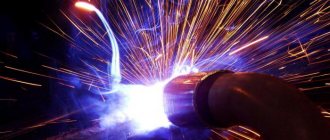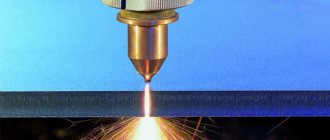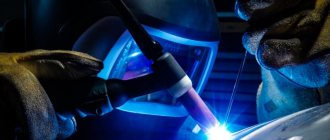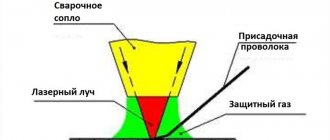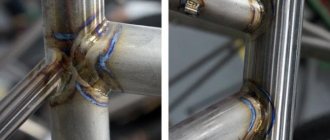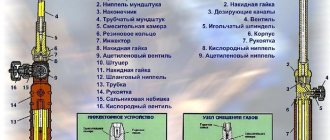Welding is the most common method of joining metal workpieces. However, the use of classical methods is not always possible. Difficulties arise when working with products that have different physical and chemical properties. The solution to the problem is explosion welding. It is used to create multilayer metal structures.
Explosive welding is a welding method based on the use of explosion energy.
Advantages and disadvantages of the method
The method is not always applicable; it requires compliance with special conditions. Despite this, the technology has advantages:
- the ability to connect parts made of materials with different chemical and physical properties;
- preservation of the characteristics of each of the components of the multilayer structure (it is possible to create compositions with the desired characteristics);
- the possibility of replacing expensive parts made of non-ferrous metals with clad ones made of ferrous ones;
- high strength of the weld (it does not change under thermal and mechanical influence on the finished structure);
- the possibility of using the method to create complex metal products (corner and curved surfaces can be processed);
- high work productivity.
The method has both advantages and disadvantages.
The main negative quality is the inability to constantly control the process. The blast wave generated during operation is dangerous. Welding is accompanied by a sharp increase in noise level. Other negative aspects include:
- the need to work in specialized metal chambers;
- the need to create reinforced concrete substrates for welding sheet metals;
- the possibility of reducing the strength of the seam during further processing of the metal structure;
- the need for careful compliance with safety rules when using explosives;
- the need for lengthy pre-treatment of welded elements;
- the need to train personnel; replacing specialists with robots is impossible.
The advantages of explosion welding include the high speed of the process.
Features of micro-inhomogeneity of welded joints
Chemical and physical microheterogeneity of welded joints manifests itself when using almost all types of welding. The features include several points:
- Physical heterogeneity is detected using metallography. Due to this, the strength of the resulting structure is significantly reduced.
- Chemical heterogeneity can also significantly reduce the quality of the connection.
That is why, when the connection zone is exposed to high temperatures, the strength and reliability coefficient can significantly decrease.
Application of explosive technology
This method creates different types of multilayer materials consisting of metals and plastics. Explosive welding is used for:
- increasing the strength of equipment components that must have high wear resistance and operate at extreme temperatures;
- coating cast and hollow parts with a protective layer;
- creating composite structures in the form of pipes.
Welded elements are leveled by pressing and rolling.
To remove excess stress and reduce hardness, the material is subjected to heat. Multilayer products can be cut, ground, milled, and forged.
Features and characteristics of the process
To understand what plasma welding is, it is worth considering its important features, namely how the process is carried out. During it, a very high temperature is usually applied in the welding area, which is formed by a forced reduction in the cross-sectional dimensions of the arc and an increase in its power indicators.
The result is plasma jet welding, in which temperatures can reach up to 300,000C. But with argon arc welding they can be only 5000-70000C. During the welding process, the arc takes on a cylindrical shape, which is what allows it to maintain the same power rating along its entire length.
During plasma welding, high arc pressure is observed on the surface of the metal elements being welded. This is what makes it possible to influence almost all types of metals and alloys.
It is worth noting! Plasma welding technology can be used with small amounts of electric current. The process can be carried out at 0.2-30 A.
All these features make this type of welding almost universal. It can be successfully used in hard-to-reach areas when connecting thin aluminum sheets without possible burns. A slight change in the distance between the electrode and the workpiece does not have a strong effect on heating, which means it does not affect the quality of the seam, as happens in other types of welding.
Due to the fact that during plasma technology a large depth of heating of parts is observed, this makes it possible to do without preliminary preparation of the edges. It is allowed to weld metals with non-metals.
As a result, there is an increase in work productivity, a decrease in the temperature deformation of the welded joint, which means that the structural part does not behave. But welding with a plasma cutter allows not only welding of metal structures, but also ensures high-quality cutting of metals and non-metals in different positions.
Material requirements
When welding metals with low ductility, difficulties may arise. Connecting parts made of fusible materials requires less energy. Surfaces must be protected from the negative effects of the blast wave. It is quite difficult to produce compositions from steel with titanium or aluminum using the explosion method. The process takes place at average parameters. When joining thick sheets, interlayers are used that do not form fragile compositions with the metals being welded. The strength of the seam also depends on the hardness of the parts.
We recommend reading: How to cook semi-automatically without a gas environment
Explosion welding allows you to obtain high-quality welded joints.
Features of the explosion welding process
The welded joint is formed within millionths of a second, that is, almost instantly. A welded joint occurs due to the formation of metal bonds during joint plastic deformation of the metal surfaces being welded. The short welding time prevents the occurrence of diffusion processes. This feature allows you to weld metals that, during conventional fusion welding processes, form brittle intermetallic compounds, making the welds unusable.
Explosive welding can produce joints of unlimited area. In this case, the welding process is carried out more simply, the greater the ratio of the joint area to the thickness of the metal part being thrown. Connections with an area of 15...20 m2 were made.
| 1 – detonator; 2 – explosive charge; 3 – throwing plates; 4 – fixed plate; 5 – substrate Figure 3 – Welding three- and multi-layer flat joints simultaneously with one explosive charge | 1 – detonator; 2 – explosive charge; 3 – pipes to be connected Figure 4 – Explosion welding of pipe joints |
| 1 — detonator 2-metal prism directing the detonation wave; 3-explosive charge; 4-coated sheet; 5-throwable sheets; 6-centering base. Figure 5 - Welding two outer layers to a sheet by explosion of one point | 1 – detonator; 2 – metal cone for directing the detonation wave; 3 – explosive charge; 4 – throwing pipe; 5 – cylinder to be coated; 6 – soil. Figure 6 — External lining of cylindrical bodies with a ring explosive charge |
Along with welding of sheet parts, other technological schemes are also used, presented in Figures 3 - 7.
Explosion welding is beginning to be used for lap butt joints of some prefabricated structural elements. Promising application of explosion welding for joining reinforced metals, producing monolithic metals and alloys from powders
1-detonator; 2-metal cone to direct the detonation wave; 3 - explosive charge; 4 — throwing pipe; 5 - cylinder to be coated; 6 - centering base. Figure 6 - Welding of bimetallic cylindrical workpieces of variable diameter.
When welding sheet parts, the main mode parameters are:
installation angle of parts α = 2…16°; initial gap h = 2…13 mm; explosive detonation speed Vd = 2500…3500 m/s; impact speed Vc; speed of movement of the impact point Vк.
In practice, to determine explosion welding modes, the required detonation speed (Vd = 2500...3500 m/s), the gap size h and the inclination angle α are sequentially selected. It is possible to weld parts without a gap with h = 0 and angle a = 0°. If the main parameters are chosen optimally, then a high-quality welded joint is obtained, equal in strength to the base metal.
Welded joints produced by explosion have fairly high strength properties. During testing, the destruction of samples, as a rule, occurs along the least strong metal of the pair at some distance from the plane of the connection.
When explosive welding of sheet parts, the connection is observed over almost the entire surface. In this way, bimetallic materials are produced, which are used in structures directly after welding or after rolling, with the help of which sheets of the required sizes and thickness are produced. It is also possible to obtain not only a two-layer, but also a multi-layer bimetallic material.
The disadvantages of the process include the difficulty of welding low-plasticity, brittle metals (cast iron, high-strength titanium alloys) that are destroyed under explosive loading.
How it works
The connection of elements is carried out due to the force of the blast wave and the high-temperature influence of plasma. Materials are mutually deformed at the molecular level. A common crystal lattice appears and free electrons are formed. Melting does not occur, so no chemical effects are observed.
Explosion welding technology with diagram
The welding process has the following features:
- The parts are connected by short-term exposure. Strong pressure creates a strong seam that can withstand any mechanical load.
- The dimensions of the workpieces to be fastened are not limited. If it is necessary to connect the surfaces of dimensional products, the explosion method is the only possible one. It features high performance.
- During the welding process, the upper part rotates, the lower part remains in its original position. Conservation of energy is also observed after the explosion. Both elements begin to rotate.
- The quality of the resulting seam depends on the speed of movement of the upper plate. This parameter must be large enough so that the workpieces are firmly attached to each other. While working, you need to monitor the speed.
Explosion welding schemes.
Two welding patterns are used - parallel and angular. The lower part in both cases lies horizontally. However, with the corner method, the upper element is installed at an angle.
Influence of the initial state of metals
The quality of the resulting connection largely depends on the initial condition of the parts. The following requirements apply to materials:
- No contamination. The strength of the seam is reduced if there are traces of rust or grease on the surfaces.
- No unevenness. If the surface has pronounced defects, it must be leveled before blasting.
- Material type. If necessary, the explosion method can be used to connect carbon and alloy steels, aluminum, copper and other non-ferrous metals.
Inhomogeneous connections
This feature manifests itself to one degree or another when using any method. During explosion welding, the following symptoms may be detected:
- Physical heterogeneity. Determined using metallography. Significantly worsens the performance characteristics of the finished structure.
- Chemical heterogeneity. It also negatively affects the quality of the welded joint.
We recommend reading: What is cold welding and how to use it
Explosion welding allows you to obtain a reliable connection of heterogeneous metals.
These factors are most pronounced when connecting elements from different materials.
Selection of electrodes
The technology of manual arc welding with coated electrodes requires the use of high-quality filler material, this is an important condition. The quality of the weld depends on the choice of electrodes. The rods are selected in accordance with the type of metal that will be welded.
When carrying out manual arc surfacing with coated electrodes, it is worth taking into account the properties of the rods, which depend on the type of coating. Electrodes used for RDS typically have a rutile or basic coating.
These electrodes have important features:
- Rutile-coated electrodes are often used by beginners. This is due to the fact that when using them it is much easier to ignite and conduct an arc.
- On sale you can find a huge selection of rutile-coated electrodes - budget and expensive brands. Experienced welders do not recommend using too expensive types for welding at home, because they will not be able to fully reveal their potential.
- Rutile rods have a significant drawback - when they are used in a weld, an increased hydrogen content is observed, which can greatly deteriorate the quality of the joint.
- When using rutile-coated electrodes, it prevents excessive metal spattering during melting.
- Basic coated rods are often chosen by professional welders with extensive experience. They are quite difficult to work with, because the arc is quite difficult to ignite, and during the welding process it must always be short.
- The use of electrodes with a basic coating makes it possible to obtain excellent quality welds.
- Core coated rods are ideal for welding thin metal.
Electrodes for RDS and other types of arc welding should be selected depending on economic factors. The manual arc welding process is quite slow, so it is recommended to know the deposition rate of the rod to determine how much time and electrodes will be required to form the weld.
Note! There are high-performance seams on sale that increase the productivity of the work process. However, they are suitable for creating horizontal seams
Welding modes
The explosive method is used without clear modes and parameters, which is explained by the imperfection of the technology and the impossibility of complete control of the process. Explosion welding is considered an experimental method, not suitable for assembly line production. When planning the process, consider the following points:
- It is impossible to predict the final result, but setting parameters developed in advance will help bring it closer to the desired one.
- You won't be able to control the blast wave.
- The scheme of work is chosen taking into account the characteristics of the materials being joined. Each case has its own parameters.
Possible difficulties
- A blast wave can cause scattering of fragments of a reinforced concrete “cushion”.
- A high-quality connection is possible if the technology is followed.
- The charge must provide the required deformation rate to prevent diffuse changes in the weld area.
- One of the surfaces must be tightly secured. When parts move simultaneously, the strength of the connection is significantly reduced.
- When working on installations, it is necessary to control the speed of throwing discharges.
- There is no mathematical model of the process, so all calculations are approximate. The process itself is experimental.
List of equipment and consumables
To perform explosion welding you will need:
- 2 parts that will be connected. They can be in the form of sheets or pipes.
- A detonator that produces the current needed to cause an explosion.
- Chamber for carrying out the process. It is installed at a construction or production site. Impact-resistant materials that are insensitive to high temperatures are used to make the camera.
To carry out large-scale work, a landfill will be required. It is equipped with elements that redirect the blast wave. This increases the efficiency of welding work.
Selecting Explosives
There are many substances designed to explode. They are selected taking into account the physical properties of the metals being joined and the conditions of use. The following means are used:
- Bulk explosives. With its help, you can create a charge of any volume and shape.
- Solid explosives. Due to some features it is used less often.
Most explosives consist of chemical compounds.
Preparing for work
The quality of welded metals can be improved with careful preparation for the process. To carry out explosion welding you need:
- A more suitable explosive for the case at hand.
- A supporting foundation that must withstand strong impacts. Before starting work, you need to check the condition of the supporting foundation. Various defects can lead to the fact that the base will not withstand the impact.
- Parts to be joined. They are pre-prepared. To do this, the surface layer can be removed with an abrasive material.
- A detonator is required for an explosion.
It is worth considering that the features of the preparatory process largely depend on the type of materials being joined. Examples include the following:
- Large parts.
- Cylindrical parts.
- Multilayer and fiber reinforced parts.
Welding range
Don't forget that a foundation slab can only withstand a few explosions. After this, it is destroyed and the site has to be prepared again.
Welder safety precautions
When performing explosion welding, the following rules must be observed:
- Landfills are located away from residential buildings, industrial facilities, and public institutions. The spreading blast wave can destroy buildings.
- The work site is covered with sand. The recommended thickness of the protective cushion is 1 m. If the explosive force is more than 200 kg, the landfill is prepared in a special way.
- When processing small parts and using a weak explosive charge, a special chamber is used. The thickness of the walls of the structure must be at least 25 cm. The chamber will protect employees on site from being hit by a blast wave.
- The welder must use special clothing, respiratory and skin protection.
- Particular attention is paid to fire safety rules. An explosion often contributes to the appearance of a fire.
- Only employees with appropriate clearance can begin work.
We recommend reading Classification of the main types of fusion welding
Work technology
Explosion welding capabilities.
Based on the type of energy input, explosion welding is in the group of mechanical metal joining processes. When using this method, the chemical energy obtained from gas formation after an explosion is converted into mechanical energy, giving one of the welded parts a huge speed of movement at the moment of contact of the moving part with a fixed part at an angle to each other. In this case, contact occurs along a line, and not along the area of the parts, after which the contact surface increases.
As a result, kinetic energy arises, which is spent on joint deformation of the metal layers on both parts and the formation of a weld between them. One of the main conditions for obtaining the most durable connection is the speed imparted to the moving part. If the acceleration is insufficient, the weld may fail, just as it will fail if the acceleration is excessive. For specific purposes, you need your own value of speed parameters for throwing a product.
How to prepare
Before starting work, perform the following steps:
- Prepare the surfaces to be joined. Scale, traces of oil, oxide film or protective coatings are removed from them.
- Straighten the workpieces. A curvature of 2 mm/m² is allowed.
- Creates slight roughness.
- Compare details. When working with sheet products, the lower part is placed on a substrate, the upper part is placed parallel or at an angle. The inclination should not exceed 30°. Hollow parts are secured using special devices. A core is inserted into the pipe to prevent deformation.
- Calculate the required volume of explosive charge.
Explosion welding is used in the manufacture of billets for bimetal rolling.
Bath method of welding reinforcement
Many of us are familiar with reinforcement, which is actively used in monolithic frame construction. It is used in floor blocks, piles, etc. Let's take a closer look at the features of such welding. Most often it is used for horizontal rods. The essence of the method is that a steel mold is welded at the joint. Then a bath of molten metal is created in it due to the heat of the arc. It turns out that the ends of the welded reinforcement melt and form a common pool. Accordingly, upon cooling, a complete compound is formed.
But before starting welding, it is necessary to prepare the rods. This is done as follows: the surfaces, as well as the ends, are cleaned, and any type of contamination is removed, for example, rust, scale and dirt. A metal brush is suitable for this.
By the way, it is important to strip the reinforcement to a length of 30 mm at the welding site. The rods are installed coaxially
In this case, the gap should not exceed one and a half diameters of the electrode (at the end).
The process takes place under high currents. For example, with a 6 mm electrode, the welding unit operates at a current of 450 Amperes. If we are talking about low temperatures, then the current is increased by 10-12%. In addition, work can be performed with several electrodes at once
It is worth paying attention to the fact that this method allows you to reduce the labor intensity of the process, the cost of the product, as well as energy consumption. Today, the tubular method of welding reinforcement is the most popular and reliable
This is due to low power consumption and high quality connection.
Step-by-step instruction
The connection of parts using the explosion method is performed as follows:
- The matched parts are laid on a supporting foundation. It can be poured from concrete reinforced with a reinforcement cage.
- Sprinkle nitrate or ammonal over the top layer. Cover the joint with an explosive, distributing it evenly. After this, a detonator is installed.
- The explosion process is started. After its completion, the workpiece is left. You can remove it from the camera or fixing device after a minute. Due to the strong impact, individual sheets are transformed into a multilayer structure.
Compliance with quality standards and compliance testing
To assess the strength and homogeneity of a welded joint obtained by explosion, the following methods are used:
- Ultrasonic flaw detection. The method is used to assess the strength of seams. The fluoroscopic method is used to check important connections.
- The seam is cut or torn. Also used to evaluate strength.
- Deflections and torsion of the connection. They help evaluate the ductility of the resulting structure.
If in doubt, a warp check is required. To do this, measure the thickness of the material in several places.
What you need to know
The main feature is the ability to process metal surfaces of any type. The selected connections can be of any size, which is an additional advantage. Explosion welding, the diagram of which is presented above, provides instant high-quality joints, which are formed in less than a millionth of a second.
It is worth noting that if it is necessary to reheat finished surfaces, one should remember the high risk of developing active diffusion; it may appear at the site of the previously obtained connection. Because of this, there is a high probability of a significant decrease in strength and reliability characteristics, especially when exposed to a high temperature range.
To prevent such detrimental changes during the joining process, special metal-based interlayers are used, while the surfaces undergoing treatment and the additives used do not form chemical compounds. An example is the welding of titanium and steel; in this case, materials such as vanadium or tantalum are used as a special layer.
What difficulties will you face?
Explosion welding is associated with many difficulties, which include:
- Difficulty in storing, transporting and using explosives.
- Impossibility of eliminating the dangerous impact of an explosion on the environment. Carrying out the welding process at special sites helps minimize harm. They are located as far as possible from cities, villages and holiday villages.
- Reduced weld strength when working with dissimilar metals.
- The need for careful preparation of products. It is necessary to clean the surfaces of the sheets to a metallic shine.
- Difficulty in calculating the required volume of explosives. In most cases, values are chosen empirically.
It is almost impossible to create the most favorable conditions for explosive welding.
How is explosion welding performed?
In order to obtain a solid product from dissimilar parts, the following algorithm is implemented:
- The base metal is placed on a fixed base.
- A cladding metal is placed on top at a short distance, which is covered with a uniform layer of explosive.
- When an explosive detonates, an explosion occurs, the front of which spreads from one edge of the workpiece to the other.
- As a result of the explosive impact, the cladding element receives ultra-high kinetic energy, which leads to the formation of a force reaching several hundred kilotons.
- The collision of the materials being joined causes heating of the surface of the layers and the formation of a plasma jet, which leads to the exchange of electrons and the formation of strong bonds.
The physics of this process is somewhat similar to the process of electron beam welding, where, due to high kinetic energy, electrons penetrate deep into the metal surface, causing it to heat up. However, if in the implementation of EBW the energy source is a high-power beam, then in this case the electronic exchange is achieved due to the energy released during the detonation of the explosive. By the way, you can read more about electron beam technology here.
Reliability is visible to the naked eye
The strength of a welded joint largely depends on the amount and speed of detonation of the explosive. These indicators are usually selected experimentally, and both a shortage and an excess of explosives can have a negative effect. Also, to improve the strength of the structure, a thin layer of vanadium, niobium or tantalum is sometimes inserted between the base materials, which does not corrode during operation and helps maintain the integrity of the weld.
How they do it in the West (en):
Specific features of the welding process
In theory, the explosive technique for producing bimetallic bonds is not very complicated, but in practice its implementation is often difficult. This is due to the harmful effects of the shock wave on the environment and the need to store explosives. To maintain process safety, such work is carried out at test sites located in areas with low seismic activity. If the parts to be welded are small in size, it is possible to use special chambers, the walls of which must withstand the load created by the shock wave.
As already noted, the selection of the amount of explosive is carried out experimentally. It is very difficult to make accurate calculations, since you cannot simply stop or slow down the process at a certain stage in order to study it in detail and develop a specific scheme. Therefore, an individual approach is applied to each product, which makes automation impossible.

